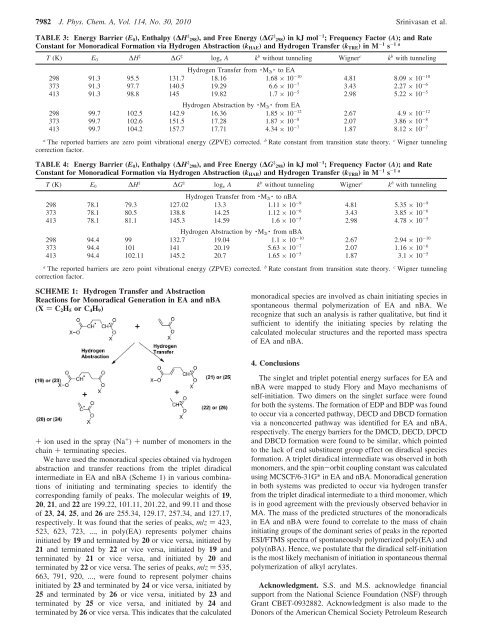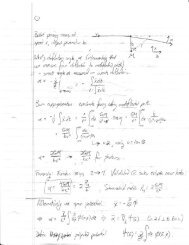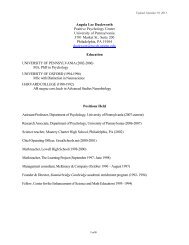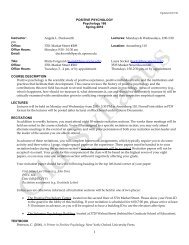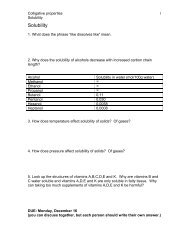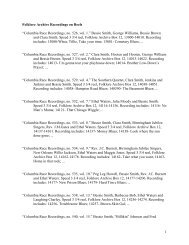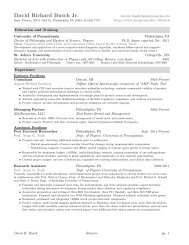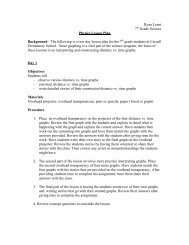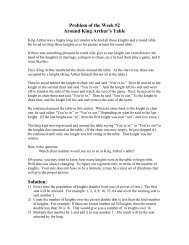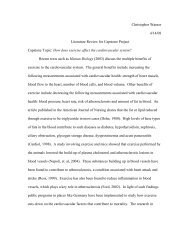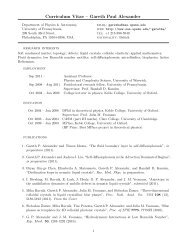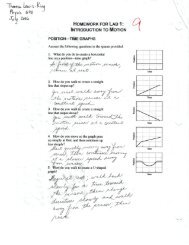Self-Initiation Mechanism in Spontaneous Thermal Polymerization of ...
Self-Initiation Mechanism in Spontaneous Thermal Polymerization of ...
Self-Initiation Mechanism in Spontaneous Thermal Polymerization of ...
You also want an ePaper? Increase the reach of your titles
YUMPU automatically turns print PDFs into web optimized ePapers that Google loves.
7982 J. Phys. Chem. A, Vol. 114, No. 30, 2010 Sr<strong>in</strong>ivasan et al.<br />
TABLE 3: Energy Barrier (E 0 ), Enthalpy (∆H ‡ 298), and Free Energy (∆G ‡ 298) <strong>in</strong>kJmol -1 ; Frequency Factor (A); and Rate<br />
Constant for Monoradical Formation via Hydrogen Abstraction (k HAE ) and Hydrogen Transfer (k TRE )<strong>in</strong>M -1 s -1 a<br />
T (K) E 0 ∆H ‡ ∆G ‡ log e A k b without tunnel<strong>in</strong>g Wigner c k b with tunnel<strong>in</strong>g<br />
Hydrogen Transfer from · M 2t · to EA<br />
298 91.3 95.5 131.7 18.16 1.68 × 10 -10 4.81 8.09 × 10 -10<br />
373 91.3 97.7 140.5 19.29 6.6 × 10 -7 3.43 2.27 × 10 -6<br />
413 91.3 98.8 145 19.82 1.7 × 10 -5 2.98 5.22 × 10 -5<br />
Hydrogen Abstraction by · M 2t · from EA<br />
298 99.7 102.5 142.9 16.36 1.85 × 10 -12 2.67 4.9 × 10 -12<br />
373 99.7 102.6 151.5 17.28 1.87 × 10 -8 2.07 3.86 × 10 -8<br />
413 99.7 104.2 157.7 17.71 4.34 × 10 -7 1.87 8.12 × 10 -7<br />
a The reported barriers are zero po<strong>in</strong>t vibrational energy (ZPVE) corrected. b Rate constant from transition state theory. c Wigner tunnel<strong>in</strong>g<br />
correction factor.<br />
TABLE 4: Energy Barrier (E 0 ), Enthalpy (∆H ‡ 298), and Free Energy (∆G ‡ 298) <strong>in</strong>kJmol -1 ; Frequency Factor (A); and Rate<br />
Constant for Monoradical Formation via Hydrogen Abstraction (k HAB ) and Hydrogen Transfer (k TRB )<strong>in</strong>M -1 s -1 a<br />
T (K) E 0 ∆H ‡ ∆G ‡ log e A k b without tunnel<strong>in</strong>g Wigner c k b with tunnel<strong>in</strong>g<br />
Hydrogen Transfer from · M 2t · to nBA<br />
298 78.1 79.3 127.02 13.3 1.11 × 10 -9 4.81 5.35 × 10 -9<br />
373 78.1 80.5 138.8 14.25 1.12 × 10 -6 3.43 3.85 × 10 -6<br />
413 78.1 81.1 145.3 14.59 1.6 × 10 -5 2.98 4.78 × 10 -5<br />
Hydrogen Abstraction by · M 2t · from nBA<br />
298 94.4 99 132.7 19.04 1.1 × 10 -10 2.67 2.94 × 10 -10<br />
373 94.4 101 141 20.19 5.63 × 10 -7 2.07 1.16 × 10 -6<br />
413 94.4 102.11 145.2 20.7 1.65 × 10 -5 1.87 3.1 × 10 -5<br />
a The reported barriers are zero po<strong>in</strong>t vibrational energy (ZPVE) corrected. b Rate constant from transition state theory. c Wigner tunnel<strong>in</strong>g<br />
correction factor.<br />
SCHEME 1: Hydrogen Transfer and Abstraction<br />
Reactions for Monoradical Generation <strong>in</strong> EA and nBA<br />
(X ) C 2 H 5 or C 4 H 9 )<br />
monoradical species are <strong>in</strong>volved as cha<strong>in</strong> <strong>in</strong>itiat<strong>in</strong>g species <strong>in</strong><br />
spontaneous thermal polymerization <strong>of</strong> EA and nBA. We<br />
recognize that such an analysis is rather qualitative, but f<strong>in</strong>d it<br />
sufficient to identify the <strong>in</strong>itiat<strong>in</strong>g species by relat<strong>in</strong>g the<br />
calculated molecular structures and the reported mass spectra<br />
<strong>of</strong> EA and nBA.<br />
4. Conclusions<br />
+ ion used <strong>in</strong> the spray (Na + ) + number <strong>of</strong> monomers <strong>in</strong> the<br />
cha<strong>in</strong> + term<strong>in</strong>at<strong>in</strong>g species.<br />
We have used the monoradical species obta<strong>in</strong>ed via hydrogen<br />
abstraction and transfer reactions from the triplet diradical<br />
<strong>in</strong>termediate <strong>in</strong> EA and nBA (Scheme 1) <strong>in</strong> various comb<strong>in</strong>ations<br />
<strong>of</strong> <strong>in</strong>itiat<strong>in</strong>g and term<strong>in</strong>at<strong>in</strong>g species to identify the<br />
correspond<strong>in</strong>g family <strong>of</strong> peaks. The molecular weights <strong>of</strong> 19,<br />
20, 21, and 22 are 199.22, 101.11, 201.22, and 99.11 and those<br />
<strong>of</strong> 23, 24, 25, and 26 are 255.34, 129.17, 257.34, and 127.17,<br />
respectively. It was found that the series <strong>of</strong> peaks, m/z ) 423,<br />
523, 623, 723, ..., <strong>in</strong> poly(EA) represents polymer cha<strong>in</strong>s<br />
<strong>in</strong>itiated by 19 and term<strong>in</strong>ated by 20 or vice versa, <strong>in</strong>itiated by<br />
21 and term<strong>in</strong>ated by 22 or vice versa, <strong>in</strong>itiated by 19 and<br />
term<strong>in</strong>ated by 21 or vice versa, and <strong>in</strong>itiated by 20 and<br />
term<strong>in</strong>ated by 22 or vice versa. The series <strong>of</strong> peaks, m/z ) 535,<br />
663, 791, 920, ..., were found to represent polymer cha<strong>in</strong>s<br />
<strong>in</strong>itiated by 23 and term<strong>in</strong>ated by 24 or vice versa, <strong>in</strong>itiated by<br />
25 and term<strong>in</strong>ated by 26 or vice versa, <strong>in</strong>itiated by 23 and<br />
term<strong>in</strong>ated by 25 or vice versa, and <strong>in</strong>itiated by 24 and<br />
term<strong>in</strong>ated by 26 or vice versa. This <strong>in</strong>dicates that the calculated<br />
The s<strong>in</strong>glet and triplet potential energy surfaces for EA and<br />
nBA were mapped to study Flory and Mayo mechanisms <strong>of</strong><br />
self-<strong>in</strong>itiation. Two dimers on the s<strong>in</strong>glet surface were found<br />
for both the systems. The formation <strong>of</strong> EDP and BDP was found<br />
to occur via a concerted pathway, DECD and DBCD formation<br />
via a nonconcerted pathway was identified for EA and nBA,<br />
respectively. The energy barriers for the DMCD, DECD, DPCD<br />
and DBCD formation were found to be similar, which po<strong>in</strong>ted<br />
to the lack <strong>of</strong> end substituent group effect on diradical species<br />
formation. A triplet diradical <strong>in</strong>termediate was observed <strong>in</strong> both<br />
monomers, and the sp<strong>in</strong>-orbit coupl<strong>in</strong>g constant was calculated<br />
us<strong>in</strong>g MCSCF/6-31G* <strong>in</strong> EA and nBA. Monoradical generation<br />
<strong>in</strong> both systems was predicted to occur via hydrogen transfer<br />
from the triplet diradical <strong>in</strong>termediate to a third monomer, which<br />
is <strong>in</strong> good agreement with the previously observed behavior <strong>in</strong><br />
MA. The mass <strong>of</strong> the predicted structures <strong>of</strong> the monoradicals<br />
<strong>in</strong> EA and nBA were found to correlate to the mass <strong>of</strong> cha<strong>in</strong><br />
<strong>in</strong>itiat<strong>in</strong>g groups <strong>of</strong> the dom<strong>in</strong>ant series <strong>of</strong> peaks <strong>in</strong> the reported<br />
ESI/FTMS spectra <strong>of</strong> spontaneously polymerized poly(EA) and<br />
poly(nBA). Hence, we postulate that the diradical self-<strong>in</strong>itiation<br />
is the most likely mechanism <strong>of</strong> <strong>in</strong>itiation <strong>in</strong> spontaneous thermal<br />
polymerization <strong>of</strong> alkyl acrylates.<br />
Acknowledgment. S.S. and M.S. acknowledge f<strong>in</strong>ancial<br />
support from the National Science Foundation (NSF) through<br />
Grant CBET-0932882. Acknowledgment is also made to the<br />
Donors <strong>of</strong> the American Chemical Society Petroleum Research


